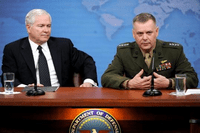Back before the Iraq surge, "military operations other than war" -- a now-antiquated term referring to non-traditional warfare -- were treated as "lesser includeds," filed deep under subsections of big-war plans, doctrine, and acquisition strategies. Today, by contrast, the U.S. national security establishment is increasingly embracing what I like to call the "greater inclusive" paradigm, which recognizes our military's rising quotient of such operations, not as some rare exception, but rather as the new rule.
Thanks to Iraq and now Afghanistan-Pakistan, the military no longer assumes that any force constructed and trained for big wars can automatically handle the "other than" stuff -- such as pre- and post-conflict stability operations, humanitarian and disaster relief ops, and counterinsurgency efforts. What was once a top-down presumption has been recast as a bottom-up prerequisite.
It is hard to exaggerate the change represented by this historic shift, which pulls the U.S. military back toward the sort of frontier-integrating mindset that dominated its thinking from the beginning of our union until we assumed global power in World War II. It also puts huge pressure on America's military-industrial complex. Today, it's not enough for defense contractors to propose a platform (e.g., aircraft, ship or ground vehicle) that performs well at the top of the conflict spectrum. It must also "stretch" well, down through its nether regions, spreading multipurpose function across the spectrum of "hybrid" conflicts, which are expected to feature warfare both large and small, conventional and non-traditional.

